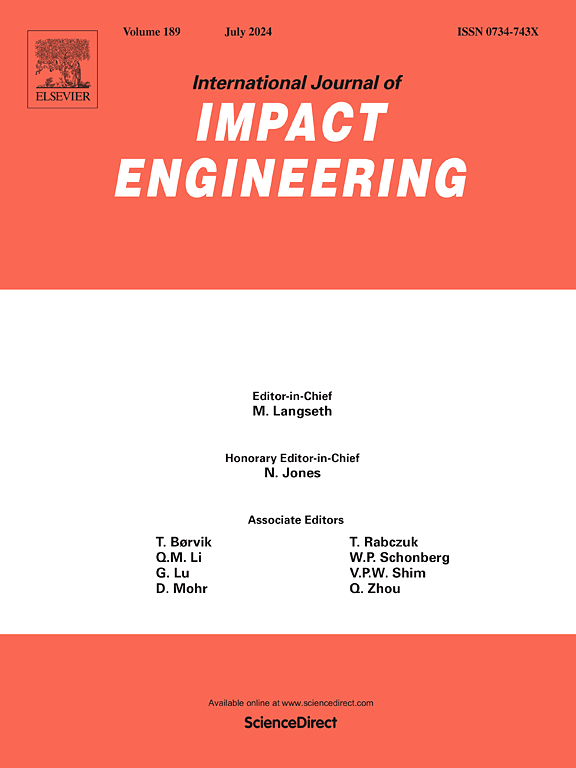High-velocity laser-driven flyer impact on paraffin gel
IF 5.1
2区 工程技术
Q1 ENGINEERING, MECHANICAL
International Journal of Impact Engineering
Pub Date : 2025-03-22
DOI:10.1016/j.ijimpeng.2025.105311
引用次数: 0
Abstract
The penetrating ballistic impact of thin 100 micrometers aluminum projectiles, accelerated at high velocities by laser-induced shock wave, on parafin gel is investigated. The laser-driven flyer experiments were conducted at BELENOS laser facility and allow the acceleration of projectile at high velocity ranging from 170 m s to 710 m s. The projectile is monitored during impact and penetration into gel targets using shadowgraphy with ultra-high speed camera. Its velocity is recorded by fast-imaging technics and correlated to Photonic Doppler Velocimeter (PDV) measurements. The ballistic impact phenomena such as the splash ejection on the front face of the gel target and the cavitation effect are analyzed. The strength resistance parameter in the Poncelet model of the gel is obtained from experimental data fit, which predicts the speed of a given fragment from its penetration depth in the target. The cavity dynamics highlights the influence of the strain rate on the mechanical behavior of paraffin gel target under penetrating ballistic impact.
高速激光驱动飞片对石蜡凝胶的冲击
研究了100微米薄铝弹在激光激波高速加速下对石蜡凝胶的穿透弹道冲击。激光驱动飞片实验在BELENOS激光设备上进行,并允许弹丸在170 ~ 710 m s−1的高速加速度范围内加速。在弹丸撞击和穿透凝胶目标的过程中,使用超高速摄像机的阴影成像技术对弹丸进行监控。它的速度由快速成像技术记录,并与光子多普勒测速仪(PDV)的测量结果相关联。分析了凝胶靶前表面溅射和空化效应等弹道冲击现象。凝胶的Poncelet模型中的强度阻力参数由实验数据拟合得到,该模型通过给定碎片在目标中的穿透深度来预测其速度。空腔动力学研究强调了应变速率对石蜡凝胶靶在穿透弹道冲击下力学行为的影响。
本文章由计算机程序翻译,如有差异,请以英文原文为准。
求助全文
约1分钟内获得全文
求助全文
来源期刊

International Journal of Impact Engineering
工程技术-工程:机械
CiteScore
8.70
自引率
13.70%
发文量
241
审稿时长
52 days
期刊介绍:
The International Journal of Impact Engineering, established in 1983 publishes original research findings related to the response of structures, components and materials subjected to impact, blast and high-rate loading. Areas relevant to the journal encompass the following general topics and those associated with them:
-Behaviour and failure of structures and materials under impact and blast loading
-Systems for protection and absorption of impact and blast loading
-Terminal ballistics
-Dynamic behaviour and failure of materials including plasticity and fracture
-Stress waves
-Structural crashworthiness
-High-rate mechanical and forming processes
-Impact, blast and high-rate loading/measurement techniques and their applications
 求助内容:
求助内容: 应助结果提醒方式:
应助结果提醒方式:


